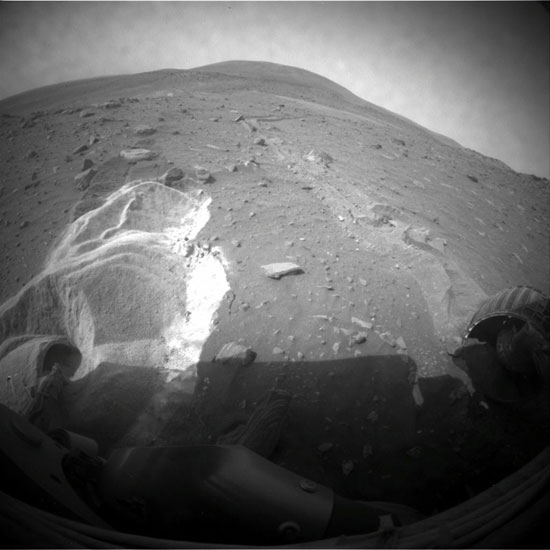Spirit Stuck in 'Insidious Invisible Rover Trap' on Mars

It couldtake week of tricky maneuvering to rescue the Mars rover Spirit from itscurrent predicament. Spirit is stuck in an "insidious invisible rover trap,"as described by Steve Squyres, lead scientist for the Mars Exploration RoverProject.
The trap isotherwise known as sandy soil, out on one of the red planet's plateaus. Butproject managers are prepared to keep at it for as long as needed and have noplans to abandon or retire the rover.
On May 6,Spirit was continuingits journey around a low plateau called "Home Plate," when it hitthe trap.
Thickdeposits of dirt lie just below the surface, covered and camouflaged by thenormal layer of dust that blankets the Martian surface. When a rover's wheelshit these patches of dirt, "the wheel can't grip" and just spins,Squyres explained.
This isexactly whathappened in Spirit's case, with the rover becoming mired up to its hubcaps,prompting the rover team to suspend all driving plans and work on a way to getthe rover out of the mire.
"Spirit'sin a tough situation," said project manager John Callas, of NASA's JetPropulsion Laboratory (JPL) in Pasadena, Calif. "It will probably be somenumber of weeks of tests" before Spirit becomes unstuck, he said.
Rescueeffort
Get the Space.com Newsletter
Breaking space news, the latest updates on rocket launches, skywatching events and more!
GettingSpirit unstuck is difficult for several reasons. For one, scientists don't knowthe exact make-up of the dirt the rover is stuck in.
The team ishaving Spirit sample its surroundings to give them some clues.
They'realso going to see how the test rover back at JPL reacts when its wheels are putin a sample of ground basaltic rock called "baghouse dust." If itspins its wheels like Spirit, they can use the Earth twin to test out ways thatSpirit might be able to dislodge itself. If it doesn't they'll have to try outother soil analogues, including the one they used when Spirit's twin,Opportunity, got stuck in a feature called Purgatory Dune in 2005.
"We'retrying to look at everything," Callas told SPACE.com.
But thereare a few issues that are complicating the rescue effort.
One addedproblem in Spirit's case is its hobbled right front wheel, which has been deadfor three year. That dead weight makes it harder to use Spirit's five remainingwheels to pull the rover out.
"We'redug in pretty deep," Squyres said.
Spirit'sleft middle wheel has been stalling, further adding to the difficulty of thetask. Callas said the team suspects there could be a rock stuck in this wheel.They're hoping the wheel will start spinning again if the rover is moved in adifferent direction.
A rockcould also be stuck underneath the lander, touching its belly plate, whichwould also make moving the rover out more dangerous and difficult.
Rovermanagers have worked out a possible way for Spirit to look underneath itselfwith its robotic arm and practiced the maneuver withOpportunity.
One pieceof good news is that gusts of wind have come along in recent days and cleanedoff the dust on Spirit's solar arrays, giving the robot a power boost.
"Sowhat this does is it buys us time," Squyres told SPACE.com,allowing mission managers to take their time in finding a solution to free therover.
And they'lllikely need that time. But that's expected, he noted, as it took several weeksto free Opportunity from Purgatory Dune.
Of course,if Spirit does get freed, there's always the chance it could stumble intoanother trap. The area is like "walking in a minefield," Callas said.
Noretirement for rovers
Squyresacknowledges that there is a chance they won't be able to get Spirit unstuck ?the rovers have far outlasted their planned lifetime and could have technicalfailures at any point (Spirit has actually experienced mysterious bouts ofamnesia and restarts in recent weeks.)
"It'sMars, these are old rover, anything could happen," Squyres said.
And there'sthe chance that permanent damage could befall one of the rovers other wheels,hobbling the robot even more.
But Spiritwon't get permanently stuck for lack of effort on the part of missionscientists.
"Ifthere's a solution, we will find it," Squyres said.
"We'llprobably always keep trying as long as we can," Callas agreed.
And therover team members are adamant that it's not yet time to retire the rovers.
"They'restill very functioning vehicles," Callas said. "There's still so muchwe can do."
Squyresagrees, arguing that because the rovers have gone so far past their missions,it's relatively cheap and easy to keep them operating, and the science to be learnedis of such interest that there's no reason not to keepthem going.
"Whynot push them?" Squyres said. "We've got nothing to lose. We can pushthem as hard as we want to now."
- Video Show ? Rover Tracks
- What Lies in Store for the Mars Rovers?
- NASA's 10 Greatest Science Missions
Join our Space Forums to keep talking space on the latest missions, night sky and more! And if you have a news tip, correction or comment, let us know at: community@space.com.

Andrea Thompson is an associate editor at Scientific American, where she covers sustainability, energy and the environment. Prior to that, she was a senior writer covering climate science at Climate Central and a reporter and editor at Live Science, where she primarily covered Earth science and the environment. She holds a graduate degree in science health and environmental reporting from New York University, as well as a bachelor of science and and masters of science in atmospheric chemistry from the Georgia Institute of Technology.









